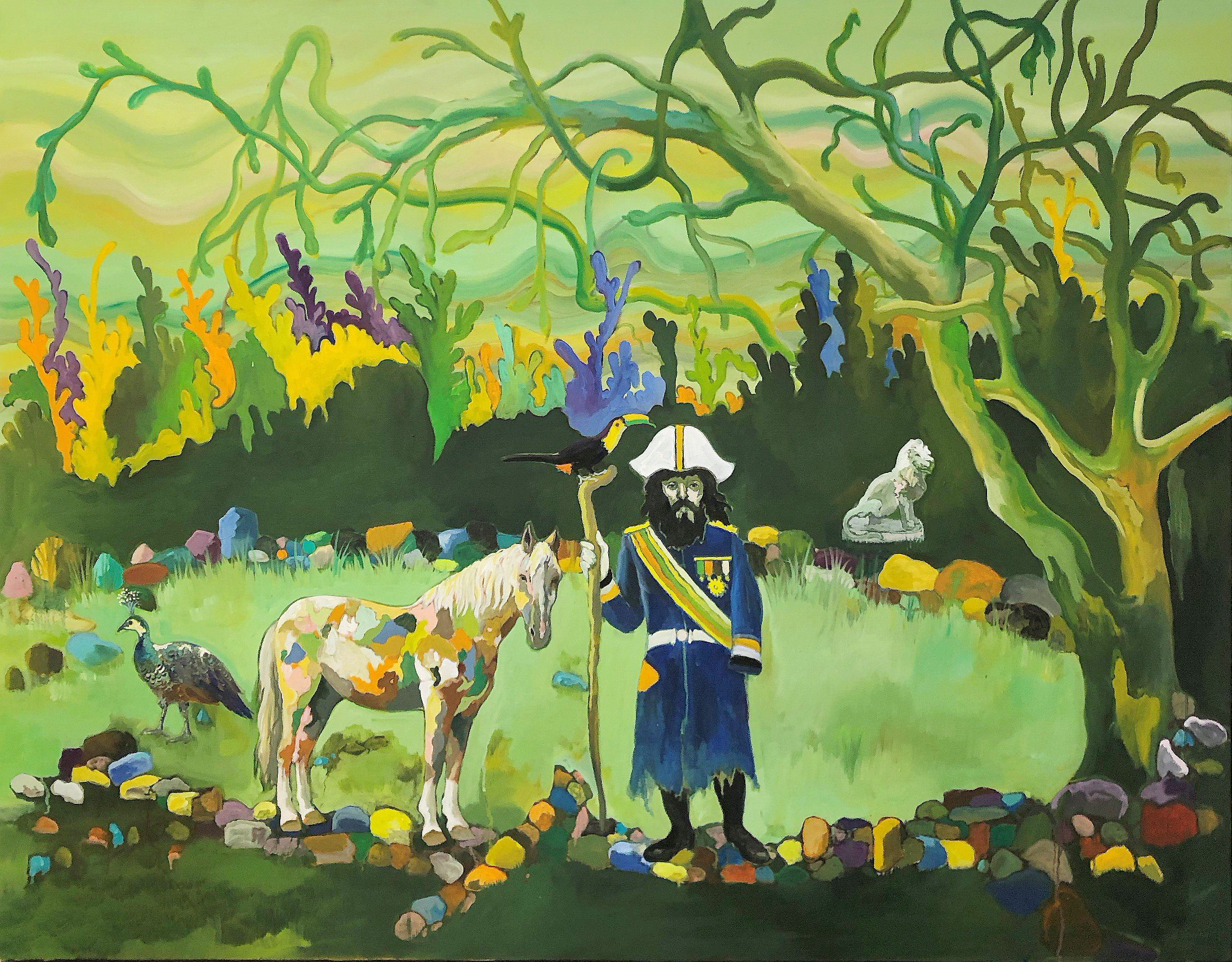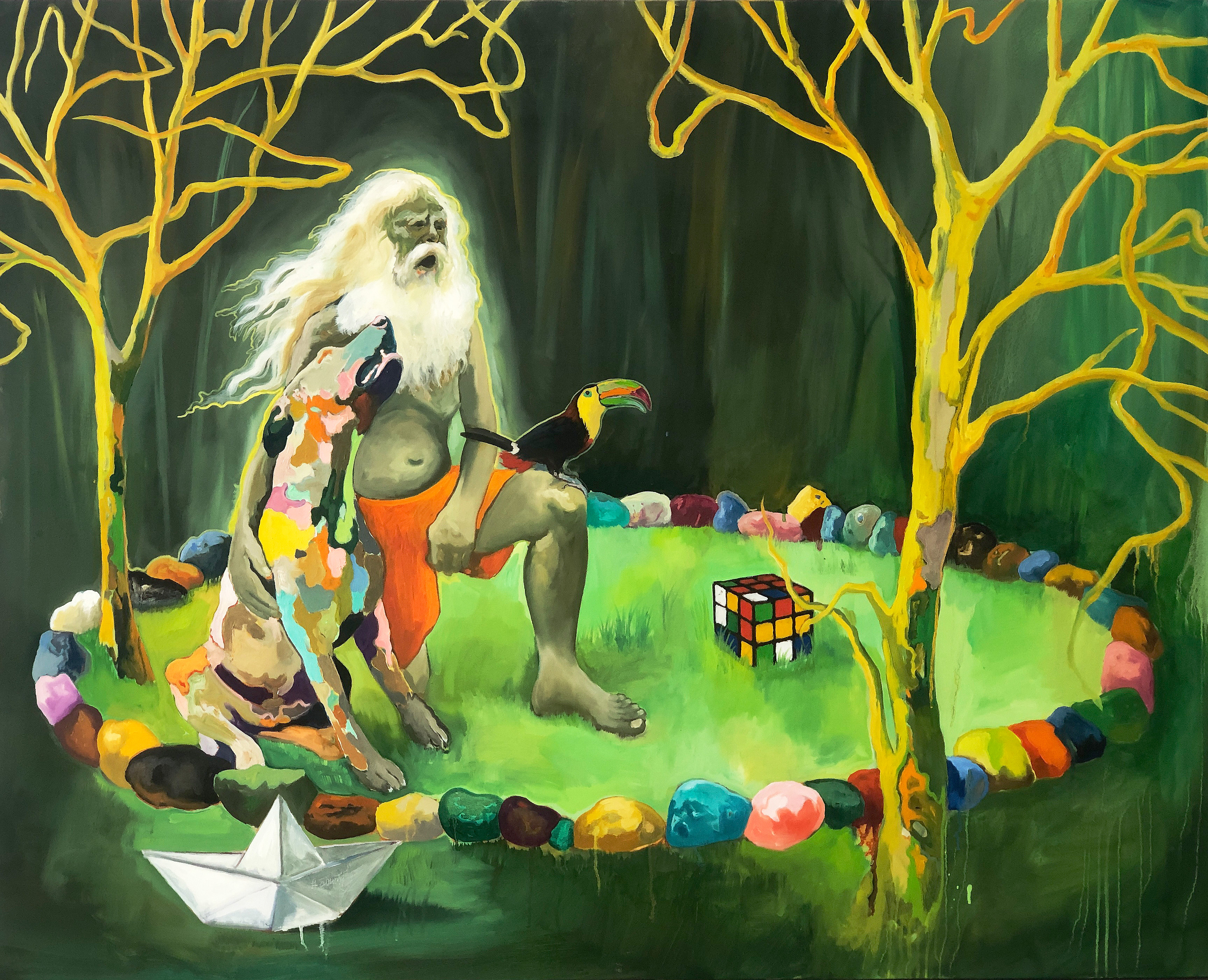Behind The Scenes | NABIL SAOUABI
May 18, 2023 - July 15, 2023 | Bhar Lazrag
This exhibition of the artist's new work will be a transcendent visual experience, taking us on a journey through space and time across the registers and themes dear to the artist, blurring the boundaries between reality and fiction.
From historical painting to cinema, to Stevenson’s Treasure Island, the staging work is pushed into spaces previously unexplored by the artist; featuring characters from Disney masterpieces, self-portraits, paper boats, figurines, birds, inverted landscapes…
Behind The Scenes, or backstage, the artist quietly grows flowers on his head, he transforms, and his work also transforms, taking place in a decor of trees, flowers, stones, landscapes in an exuberant palette layer by layer, element by element, which resists printing and seems to teeter between the natural and the artificial. The painted landscapes are not synonymous with nature—they are the transcription of the artist’s inner fascination with the world.
It is a multifaceted work in its genesis, borrowing from adventure novels, literature, art history, cinema, and even animation to shape its construction and elaboration. It draws codes and signs to create its own syntax.
The artist has achieved an almost perfect fusion and virtuoso tuning of multiple references, themes, and elements. To approach his works, one must attune as perfectly as possible to the rhythms they propose and the channels through which they operate. The themes, genres, and materials invested by the artist sometimes elude a global understanding of his work, which deliberately resists simplified comprehension, embedding the primordial meaning of the artist’s expression in its smallest components.
Is Behind the Scenes a film, a novel, a script, a painting exhibition, a fiction? Behind the Scenes is a form that introduced a style. A style containing a spirit, a temperament, an imaginative conception of the world and our relationship to it. A style that, in its diversity of resources, influences, and references, has been able to establish itself piece by piece.
ARTIST: NABIL SAOUABI
︎ Viewing Room
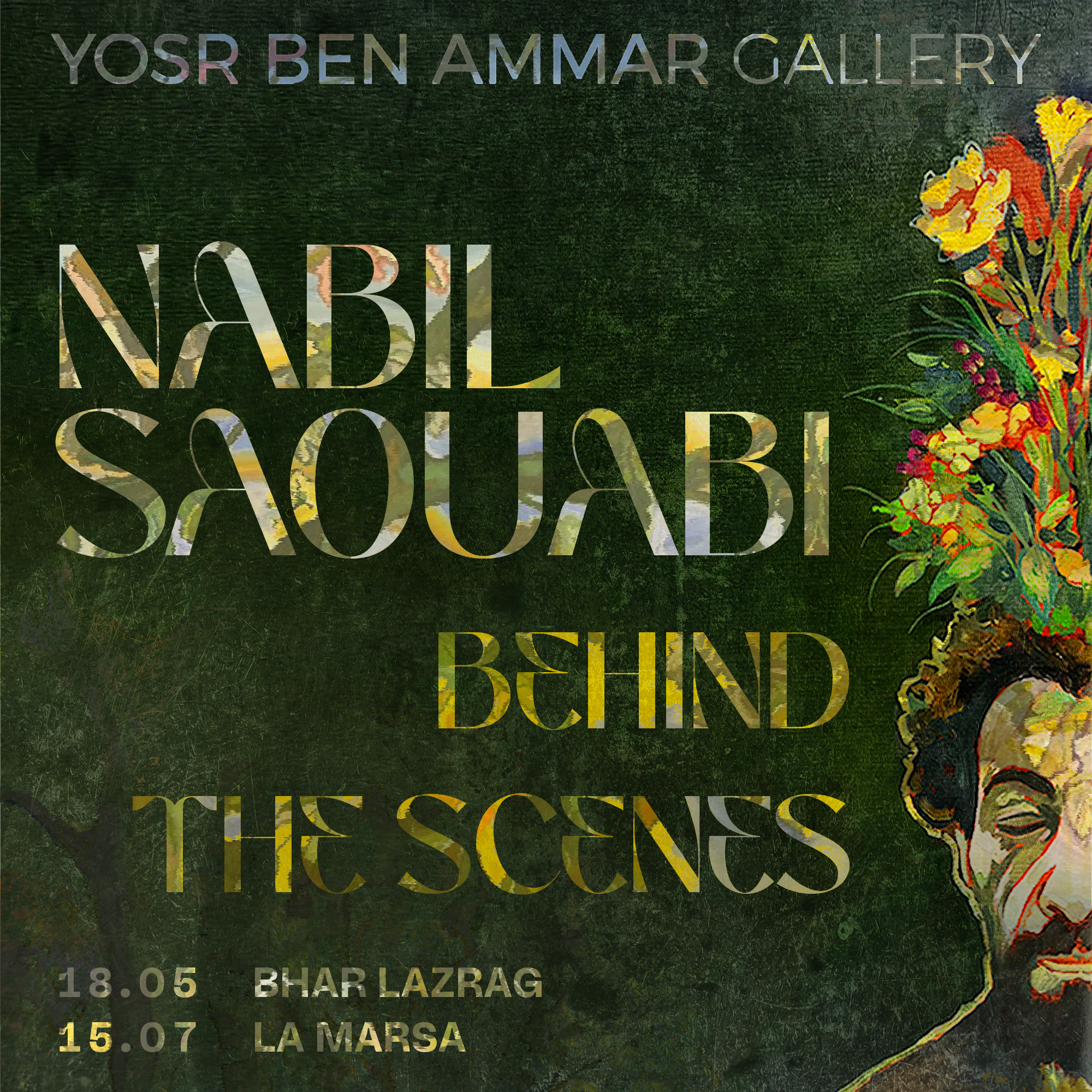
Artworks
Chapter I: Quotation and Painting
The quotation is an art, a task that must open or reopen to elsewhere, to beyond. For N.S, quotation signifies questioning a history, a heritage, a tradition that is painting. He explores the arcana of art history, and not only that, also literature. Anything that can stir his senses is employed in his work, explicitly or implicitly.
Manet’s *The Execution of Maximilian* is a very explicit quotation. Alongside Snow White, Manet’s soldiers are transformed into toy-like lead soldiers, figurines deep in a flamboyantly colored forest. Glamorous pink smoke rises from their guns like powder on Snow White’s face.
The idea of Manet in this 1868/1869 work was to denounce war scenes and horror committed before all; N.S wanted to push this idea further with a staging at the limits of extravagance. By quoting Manet’s work, N.S aligns himself in the same lineage, having previously worked on war imagery. He now pushes the idea with a sharp, conscious understanding of the pictorial elements he manipulates.
With José de Ribera’s *The Clubfoot*, it’s a different story, still historical: it concerns the artist’s positioning within art history, blending wonder, fascination, and identification, as with Goya and Stevenson.
A character, a boy of uncertain age, with a foot deformity, dressed in worn brown clothing, holding a cane and a paper reading “Nothing.” Ribera’s character stands on a green ridge, slightly from below, surrounded by trees and greenery.
The quotation of Ribera’s *Clubfoot* resonates, serving as homage but also celebrating mastery. It’s a way for the artist to rewrite his own painting history or the painting of his own history. The mastery lies in creating beauty and sublimity from the ugly and infamous, a particularity of this 1642 work not as intelligible then as it is today.
“Nothing”—there is nothing but art to reclaim humanity, nothing but art to navigate the chaos of the world.
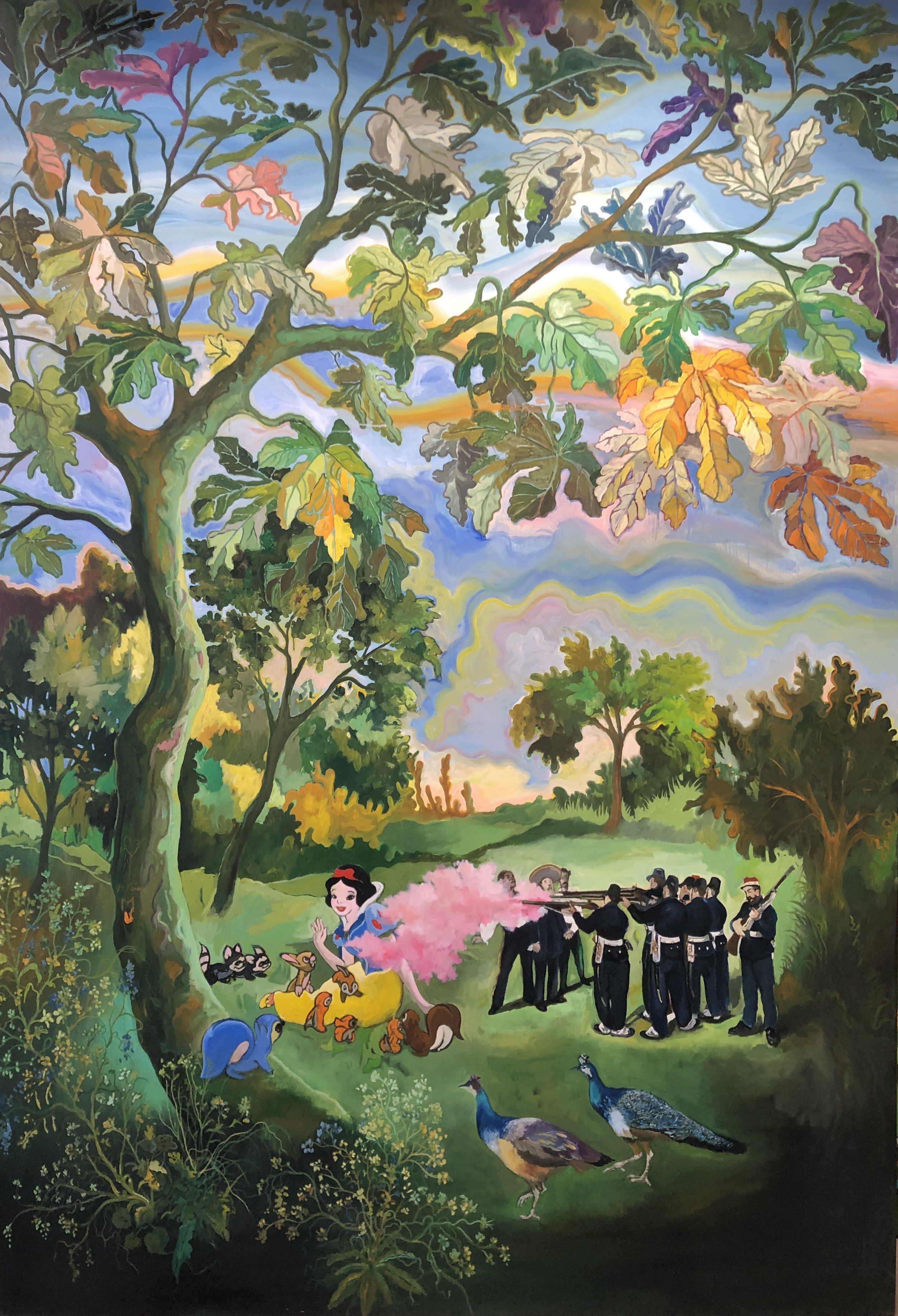
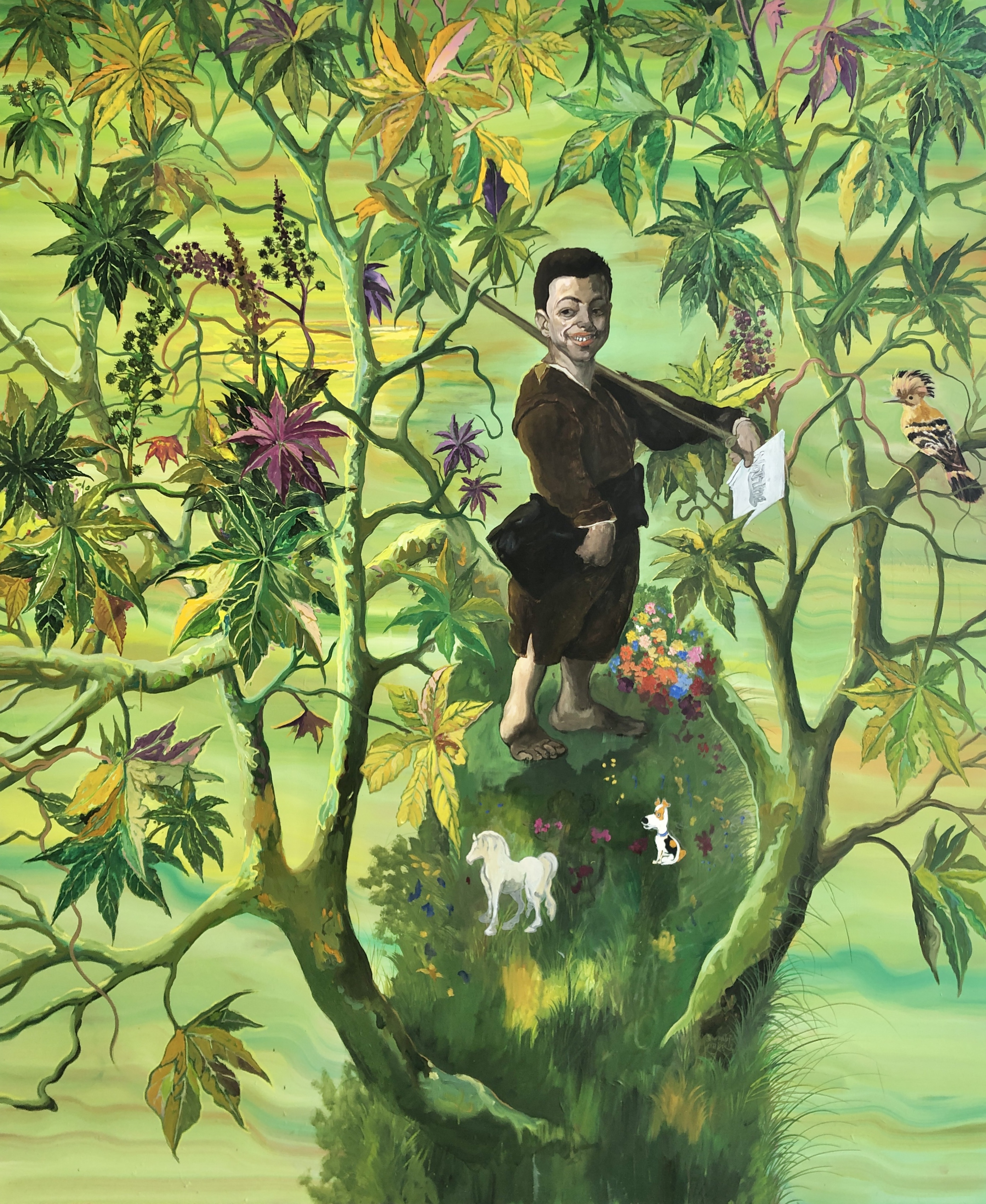
Chapter II: The Landscape
A kind of mystery surrounds N.S’s paintings; but it is a mystery that requires no explanation, one that gives rhythm to the images. A mystery produced by a certain plasticity making us sway from image to image, from work to work. Peacocks, crows, horses, stones, and trees maintain this mystery, moving and changing positions to create a unique rhythm, generating a strongly poetic mechanism in N.S’s painting. In this mechanism, the artist works in the genre of landscape, without exclusivity. A hypercolored landscape, entirely fabricated, drawing pieces from nature like a puzzle he reassembles through a creative process placing color at the center of his investigations. The colors he perceives in nature are worked, altered, multiplied, finally spreading into an almost artificial atmosphere, like a movie set.
Natural forms become the artist’s material, the tool for creating his plasticity. Yellow, red, blue stones call turtles of the same colors, purple shrubs, clouds shaped like puddles.
Beyond the landscape as a sentimental painting genre, it is, by its components, an aesthetic and a plastic form: blue stones, a red horse, a multicolored turtle, a yellow or purple tree, trees growing from outside, which modify and shape the landscape according to their placement. Thus the dimension of mystery continues to resonate throughout the works.
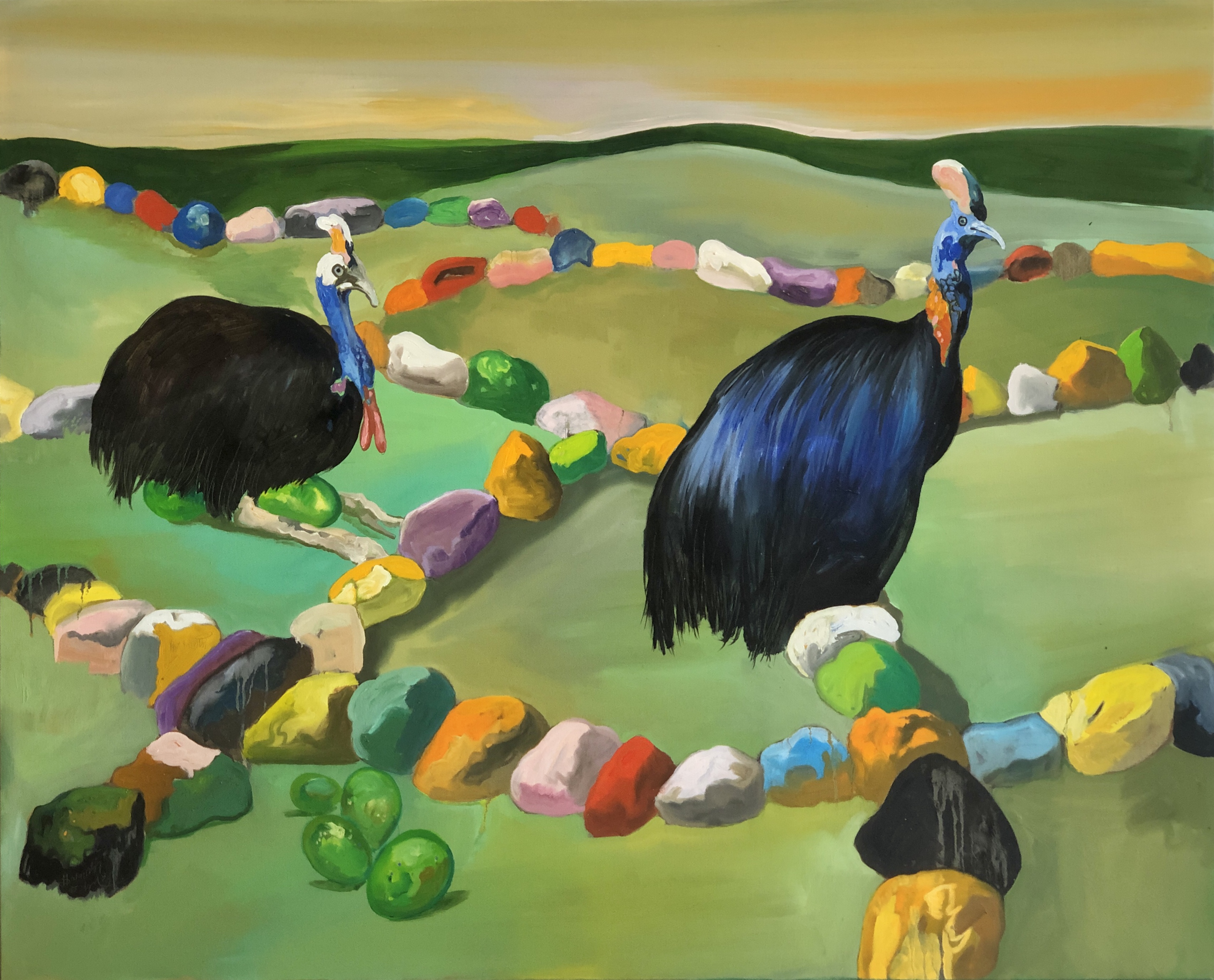

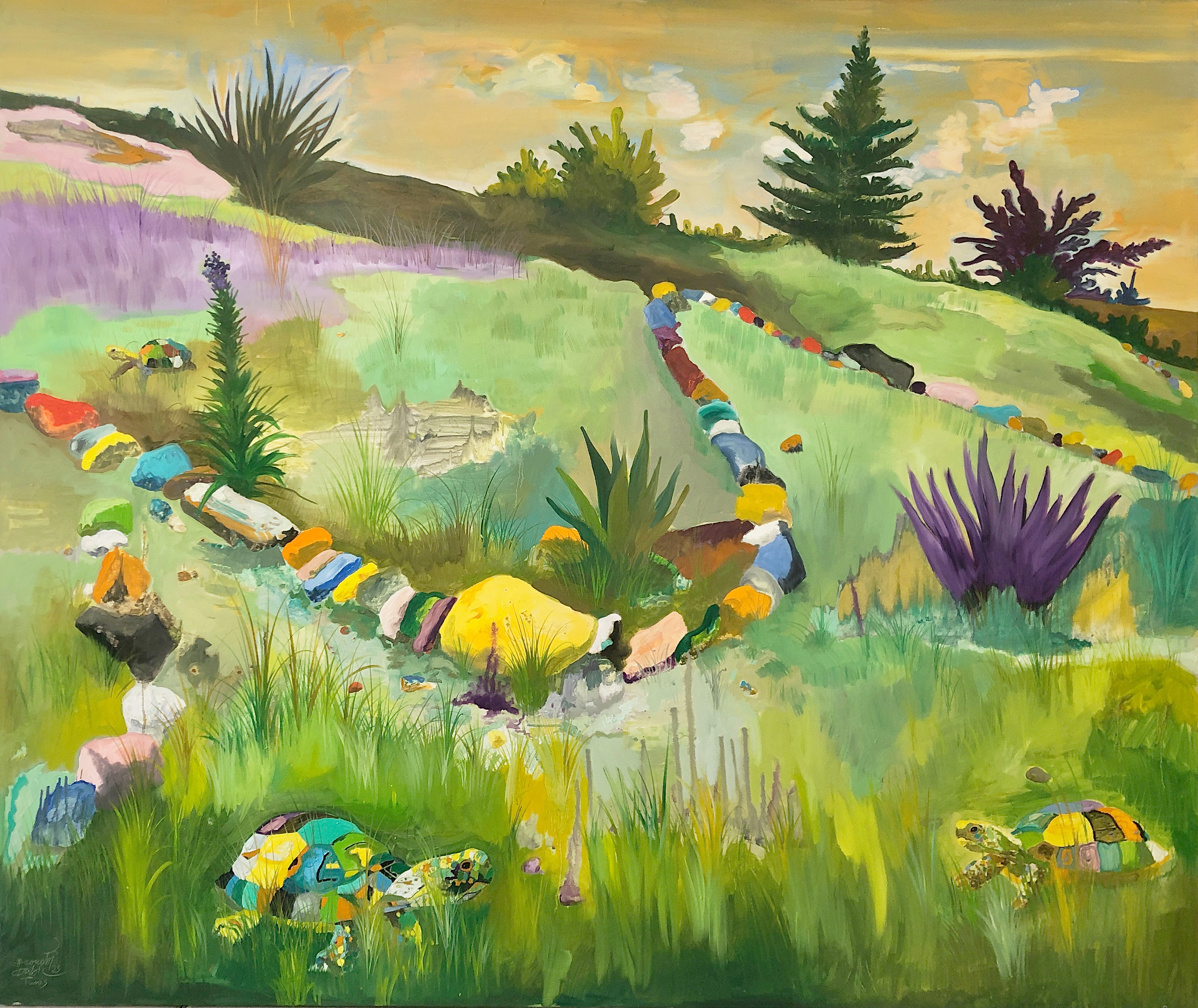
Chapter III: Staging
The pictorial image creation process for N.S initially appears as playful, curious, and pleasurable. He particularly enjoys collecting images, objects, branches, taking photos like a treasure hunt. He only begins creating the image once he has enough elements to stimulate him. This process allows a latent connection between the external world and his workspace. He sets axes, composition, overlays transparent color layers, and draws the first elements. Gradually, meaning emerges that only the artist can grasp.
Light is inherent to the objects, characters, and elements in the scene; it is uncertain, volatile, elusive. Light in N.S’s work is everywhere and nowhere. While he constructs a general luminous atmosphere, each element emits its own light, enhancing the anachronistic feel. Night scenes may have hyper-luminous yellow trees, daytime scenes may have dark backgrounds, skies may be green, yellow, and orange with restricted luminosity. Light shapes the gap between reality and fiction.
In *Boomerang*, the canvas space is where multicolored birds meet a corpse, where warriors are costumed for balls and masked. Through staging, the artist transcends the horror in the scene. Parrots, warriors, the corpse, guns, masks are treated with equal color intensity, creating internal movement with the suggested movement of bird wings.
In the painting *Mise à Mort*, the staging complicates and confuses the relations of two characters facing each other, revolvers in hand. Birds remain, carrying color, while the two characters balance pots with branches hosting various figurines. The drama is undermined by the absurdity, the game by the weapons. Fiction seeps into the decor—are we indoors or outdoors? Alive or dead?

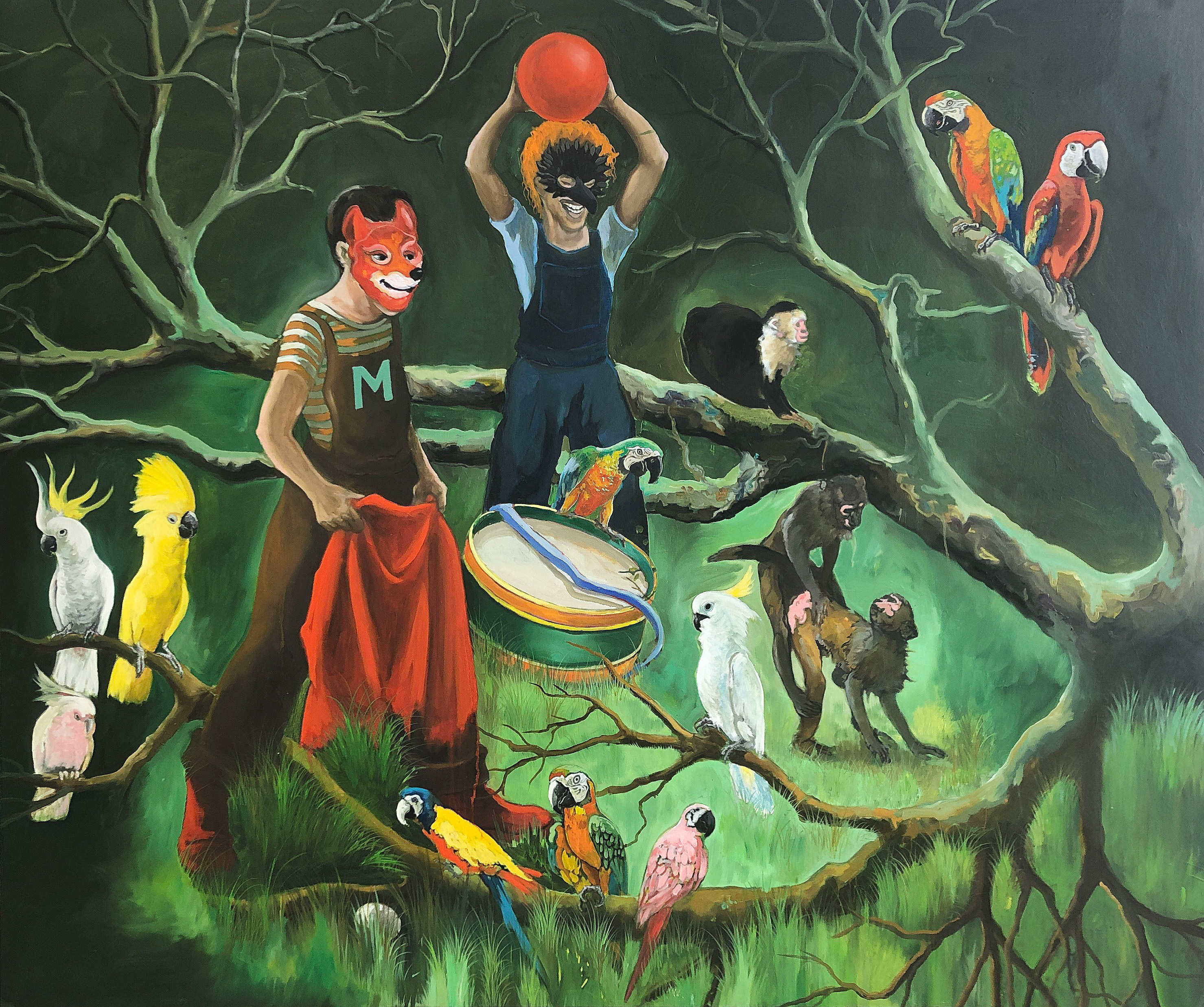
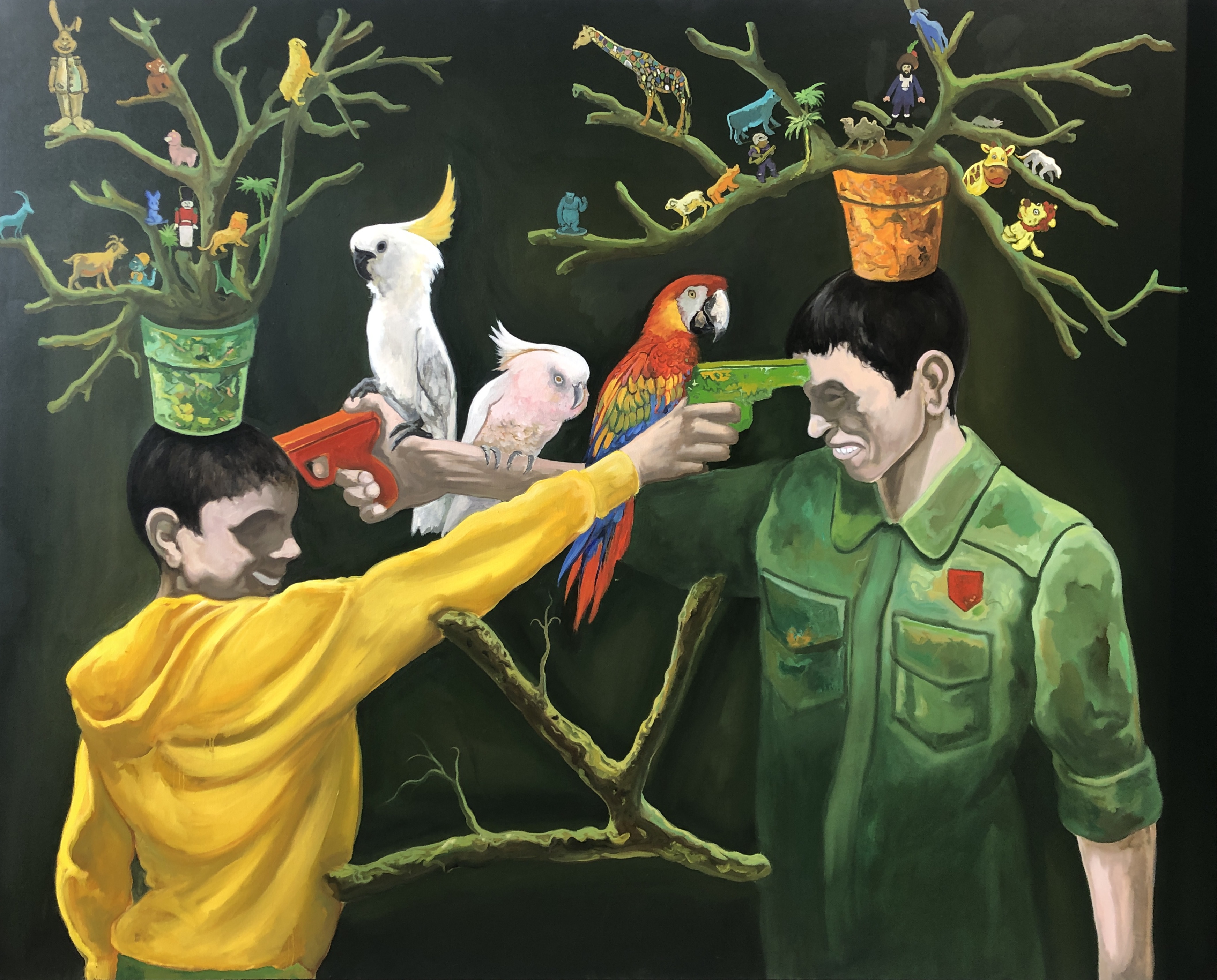
Chapter VI: Autofiction, Self-Portrait
Self-portraiture has always been present in N.S’s work. As witness, observer, artist at work, often seen from the back, he aligns with the viewer, placing himself among his characters with disarming ease, expressing a high degree of engagement in the image he creates and as actor of the scene. He claims to be both artist-model and spectator, asserting his omnipresence.
*Autoportrait aux fleurs* inaugurates this solo exhibition and sets the tone. In dark green tones, face haloed with yellow, the artist grows flowers atop his head stretching upward. With closed eyes and serene expression, he looks inward, merging with his nature—artist nature—which mirrors nature’s multiplicity, changeability, and abundance. This scene captures the artist’s inner focus in the creative process.
In *Le Rescapé*, the artist stages himself in water, holding a plant, gazing at it, with his red horse in the middle. A lion statue, tall branches, and a deserted island—*Île des Morts* by Arnold Böcklin. This self-portrait staging is a first; he immerses in water, swims in colors, placing elements of autofiction, making himself part of the narrative as survivor of the island of the dead with only a plant as trophy.
Autofiction is a way to escape what kills us and embrace what gives life.
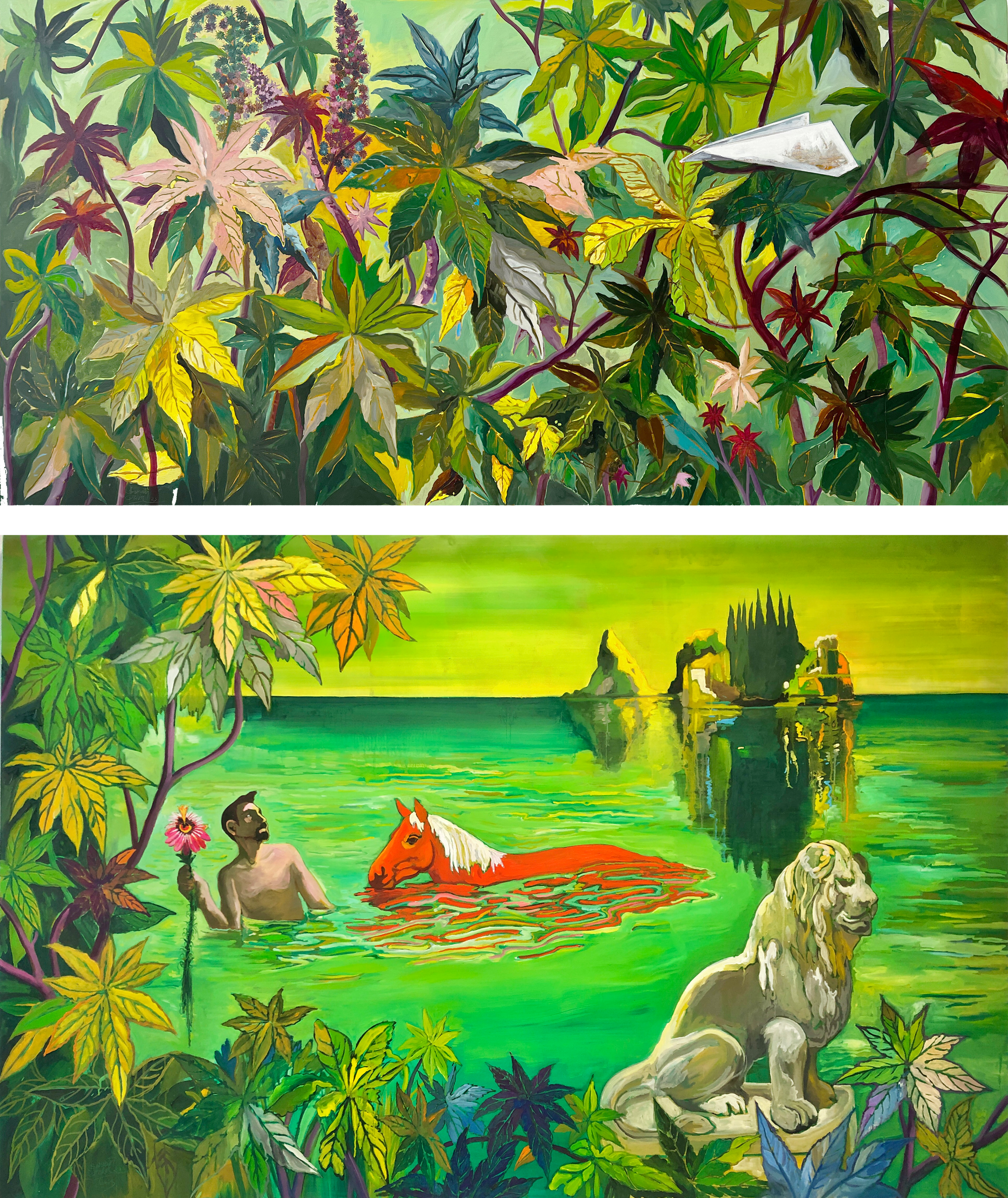
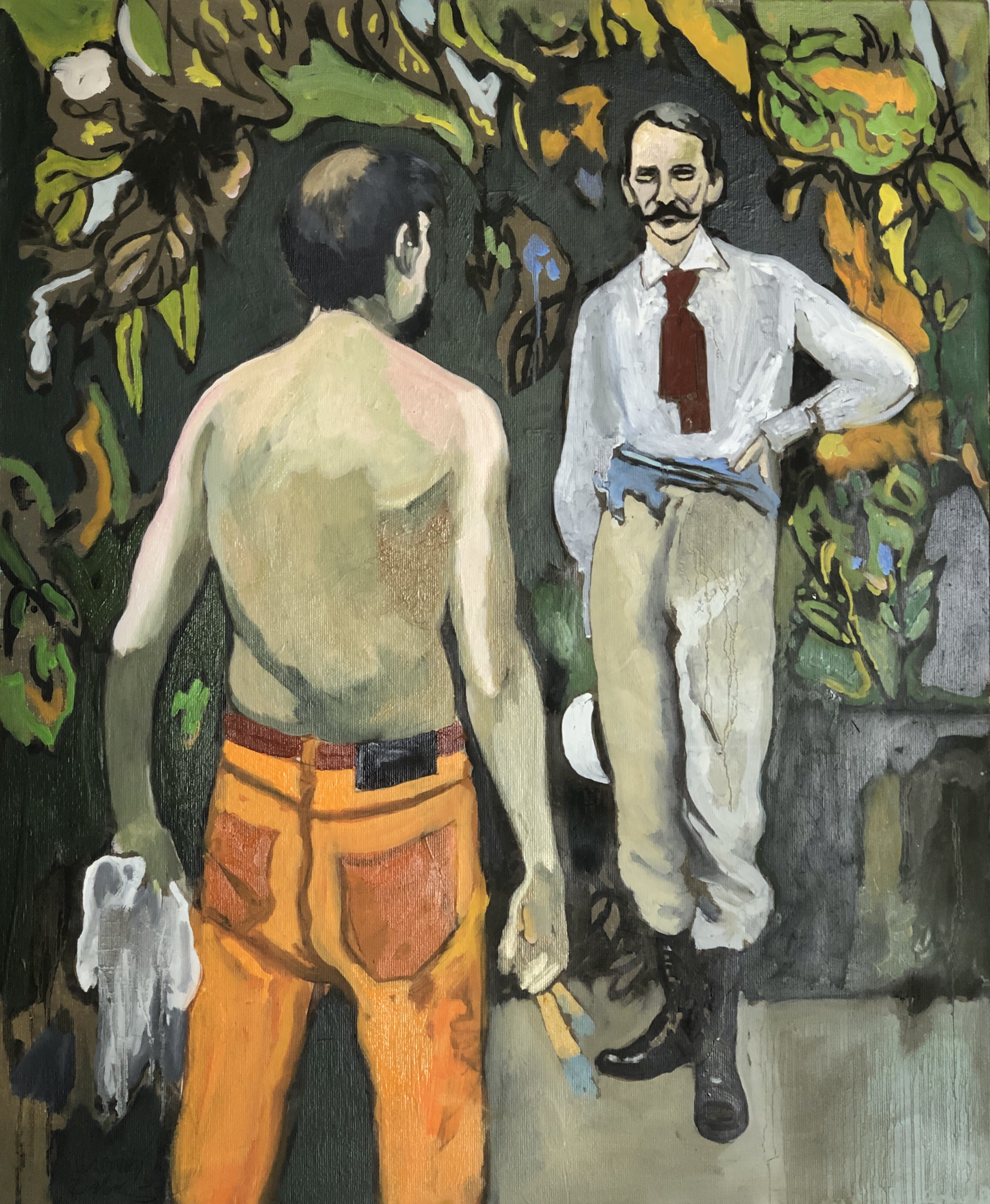



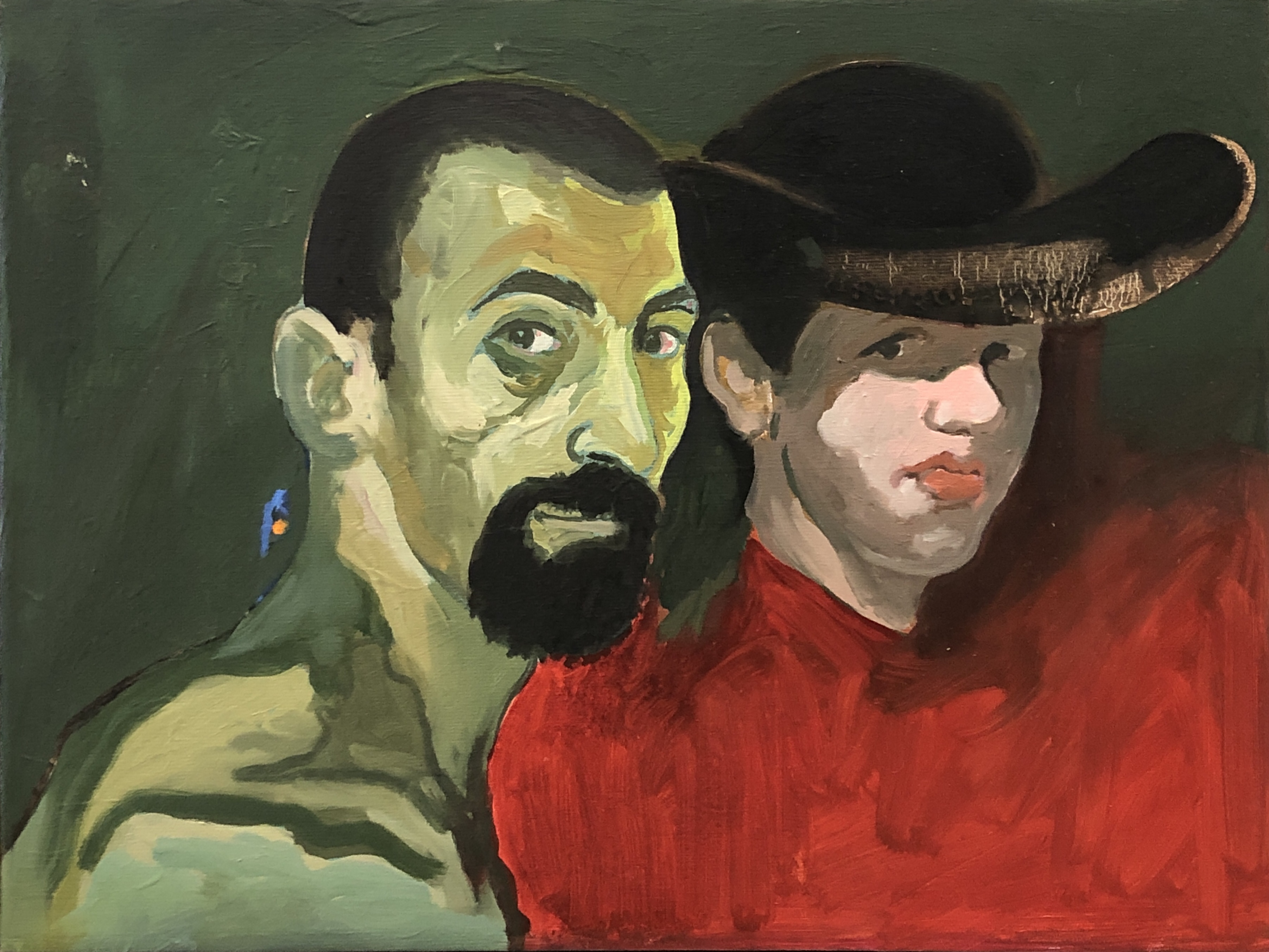
Chapter V: On Stevenson’s Path
In dialogue with Stevenson, N.S revives his childlike spirit, aimed at expanding his pictorial being. This childlike spirit seizes all senses and allows absolute freedom in scene configuration, palette, form, and expression. As a child, he enjoyed *Treasure Island* and, as an adult, he appreciates its masterful scope.
*Treasure Island* appears as the artist’s rendezvous with expanded expression, expressing a key childhood moment akin to moving from black-and-white to color TV—a precise moment of wonder, fascination, surprise, and delight. Through pirates borrowed from animation, the multicolored turtle carrying the treasure map, and parrots, he reiterates his childlike spirit, allowing absolute freedom in form, palette, and scene composition.
A Rubik’s cube, an old man, a dog, and two yellow trees inside a circle of colored stones during a nocturnal ceremony on the treasure island exude cohesion and dynamism, conceived only by a child’s spirit sharpened by adult knowledge and creator awareness.
*Treasure Island* is the backstage, where the artist exercises creative desire and simulates scenes. Gone are the artist’s old characters—primitives, naked outsiders with tragic fates. On *Treasure Island*, there is no tragedy, comedy, or drama. These are transcended by color, which refracts and divides, and the genius of staging that extracts fiction from reality. Characters detach from scene movement, aware of their presence in the moment and able to be elsewhere at any time.

